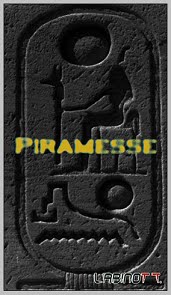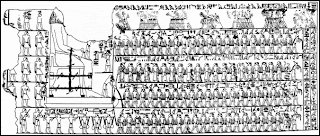
Wednesday 24 March 2010
Major Project update

Monday 22 March 2010
Sunday 14 March 2010
Major Project update
Monday 8 March 2010
Major Project update
"Moving large stones over land was more involved. Sledges and rollers (the latter being of a more limited value) were available in pharaonic times, and workers were in great supply. Friction was the main obstacle. An 800 ton block measuring 4x4x20 m would create a ground pressure of 1 kg over each square centimeter of its base. A force of at least 400 tons would be required to overcome the friction. Modern engineers working under primitive conditions found that, while moving blocks weighing 6 tons on a sledge, friction could be reduced to nearly zero by wetting the track with a lubricant (in this case, water). In the relief pictured above, from the tomb of Djehutihotep, a man can be seen on the leading end of the sledge pouring a liquid on the ground in front of it. Modern reenactments also demonstrated that a friction "seal" is formed beneath a static load that is broken when the load begins to move. An Assyrian relief (below) shows the use of a lever at the back of the sledge, possibly used to break such a "seal," or perhaps to propel it forward." ( Larry Orcutt)

Moving a stone in Assyria.
"It has been estimated that a ratio of two men per ton would be required for moving loads over flat surfaces; nine men per ton would be required for moving loads up a 9° slope. Practical experiments moving loads on a sledge over a lubricated track have shown that one man could pull one ton. Thus, the 1,000 ton colossus of Ramesses II could have been moved by 1,000 men (or 200 oxen) "(Larry Orcutt)
"The movement of large stones was not confined to Egypt in ancient times. The Romans moved the so-called Trilithon, weighing 800 tons, from the quarry to the Temple of Jupiter at Baalbek (in eastern Lebanon) in the first century AD. Another stone weighing 1,200 tons, the Hajar el Hibla ("Stone of the Pregnant Woman"), was never separated from its base and lays abandoned. Though the Romans left no record of their methods, it is obvious that the Egyptians did not have a monopoly on any "secret" technique of moving large stones."(Larry Orcutt)
at the quarry near Baalbek.
© Copyright Friedrich Ragette, Baalbek, p. 114
"It has been claimed by some that moving the largest of the Egyptian blocks would be beyond our modern-day technological capacity, even with the use of cranes and other heavy equipment. Such arguments are false. In 1999 it became necessary to move the 208-foot tall Cape Hatteras lighthouse to a location more than a half-mile away. The lighthouse weighs 4,830 tons and had to be moved in one piece in its upright position. How was this achieved?" (Larry Orcutt)
© Copyright U.S. Department of Transportation
"The use of cranes was impractical, and the actual technique used was very similar to that ascribed to the ancient Egyptians. First, the lighthouse was undercut and shored using timber (see photo below). One hundred hydraulic jacks were installed on rollers to slide along steel track beams placed beneath the lighthouse. A road was made by compacting the natural sands, overlaid with crushed stone, and finished with steel mats. Five hydraulic push jacks slowly shoved the lighthouse along the track beams in five-foot increments. The track was lubricated with soap shavings to reduce friction. The move, from start to finish, took 23 days." (Larry Orcutt)
The information provided by Larry Orcutt is a great help. Now I know that even back in the 12th dynasty, the Egyptians had a method for moving heavy objects over long distances. This means that the Pharaohs of the 21st dynasty, could have made use of the same method. The fact alone that a similar method was used even in the modern day to move the Cape Hatteras lighthouse shows that it’s very likely that the Pharaohs of the 21st dynasty could have had hundreds of men moving heavy objects on sledges over a slippery surface.
Wednesday 3 March 2010
Major Project update
Tuesday 2 March 2010
Major Project update
There will be three acts revealing the following information:
Act 1: The fact that Pi-Ramesse was found in Tanis caused a lot of confusion, since according to the ancient Egyptian documentation, it was not located there.
Act 2: The archaeologists figured out why the city was found in an unexpected place. It revealed that Pi-Ramesse’s original location was in modern day Qantir, but due to water problems it was moved to the modern day Tanis, some 200 years after the death of its creator; Ramesses the Great.
Act 3: The possible method used to move such an enormous capital over a distance of 30 km; from Qantir to Tanis.


















